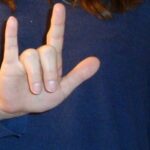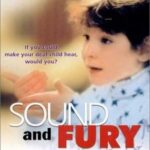As a home-schooling mother I want my children to have a well balanced education; not only to improve their minds, but also to help my children develop a better understanding of the world around them. I want my children to have as diverse an education as I can provide for them. When I was in college I originally thought to major in Education of the Deaf as I am fluent in American Sign Language and Pigeon Sign Language – both used her in the US and around the world – but eventually majored in Physics and Geology instead.
When my eldest was born I began teaching him sign language as well. Imagine if you will, being a baby – you’re tired, or hungry or sleepy, but you don’t know how to express these feelings and needs to your care-givers. The only thing you can do is cry. It’s equally frustrating for the parent at 3am trying to determine what ‘type’ of cry was piercing the air. Babies can even do basic signs as their motor skills develop much faster than their verbal ones. Therefore teaching them basic signs can be a major stress relief for both parent and child.
As a home-school mom I can demonstrate the fact that not everyone communicates in the same manner. I can explain that while some people can hear with their ears others can not, this does not make the latter stupid, just different. Now my boys (the oldest is 7) love going to our local Wal-Mart and communicating with one of the clerks who is hard of hearing. They see her as someone cool to talk to rather than someone strange.
There are a great many more resources for teaching children sign language now than when I learned it. Signing Time is one of my favorites, my boys absolutely love watching their videos. You can also print some basic words from sites such as http://www.lifeprint.com/asl101/pages-layout/concepts.htm .
Through trial and error – working with the children at a neary school for the deaf when I was in college, to teaching my own children – I’ve devised a step by step process to teaching and learning sign language.
That being said there are several different types of sign language being used today. The most prevalent in North America is American Sign Language (ASL) or Pigeon Sign (SEE, Signing Exact English). The major differences between the two are sentence structure. Pigeon Sign also known as SEE is English using signs, the sentence structure is exactly like it would be spoken by any English speaking person, “I am going to the store to buy milk” would be signed I – am – going – to – the – store – to – buy – milk. in a way this makes SEE a dialect of English rather than a ‘foreign language’. ASL on the other hand has completely different sentence structure. For the sentence “I am going to the store to buy milk” one speaking ASL would sign “me, store, milk” while making a motion with their head, hands or expression to indicate movement ( in front of them for ‘going,’ behind them for ‘went’).
Children, though, learn language word by word; especially as infants. That being the case I always suggest starting those kindergarten or younger with ASL then adding words working up to SEE. A toddler will ask for a glass of milk by saying “milk, please” very similar to ASL. As the child grows, however, they would be made to ask properly “May I have a glass of milk, please” which would be (in sign) SEE. So I suggest working word-by-word or by phrase. Which leads up to the parts of signs.
1. Finger Spelling – this is a bit more advanced for the preschool ages (even though it’s generally taught first to adults) because kids can’t spell! You’ll, of course, go over the alphabet (what better way to reinforce letters and letter sounds than by forming that very letter with their hands!)
2. Word Groups – these are words which each have a position for the hands and possibly the body associated with that one word like dog or cat, you then add it to other words to make a complete sentence. Generally speaking I break words down by association, so that it’s easier to relate them together. This way I can read a story using the similar signs while reading. The groups are:
*Family: mom/dad; boy/girl; marriage; brother/sister; grandpa/grandpa; aunt/uncle; baby
*Places: home; school; park/playground; church; kitchen;
*Indicators: (time) day/night; day/week; today (now); finish (all done); (directional’s) up/down; in/out; over/under; before/after; hot/cold
*Food: hungry; (fruits) apple/banana/peach; (drinks) water/juice/milk; (snacks) snack/crackers/cookie/cheese; (meals) breakfast/lunch/dinner/pizza/cereal/hamburger/hot dog/toast/sandwich
*Colors / Numbers: red/blue/green/brown/black/orange/yellow/white; all the numbers beginning with ones, tens then hundreds, etc.
*Animals: horse, dog, cat, cow, monkey, sheep, pig, bird, etc.
*Clothes: shirt/pants; skirt/dress; hat/gloves; shoes/socks; underwear
*Questions/Requests: help; please; how; why; where; what; stop
*Health / Feelings: happy/angry/sad/cry/like/good/bad ; wash/hurt/brush teeth/clean/sick/sleep/pain
3. Phrases – these are the most common phrases. Because of the amount of repetition in the English Language, there is a sign or set of signs for these phrases:
*Good Morning/Night ; How are you ; I love you ; Help me please ; Excuse me ; Thank you ; I’m sorry
I like to teach sign language like a circle time. But, I should also point out that this isn’t something you can do for a 45 minute lesson and expect the child to know it forever. You need to reinforce the lessons throughout the day and in the coming days to keep the information fresh and cement it in the mind. This is my Lesson Outline:
*Background – What is Sign Language? Who uses it?
*Assigning Sign Names – this is a short hands for a persons name, basically is a sign that represents a person. For instance, I studied the martial arts for years, so my name sign looks like a karate block. Kids love the idea that that they get to make up their own sign.
*Nursery Rhyme/Song – setting knowledge to music makes it much easier to remember.
*Alphabet – usually we only cover a letter or group of letter like vowels in each session (You can use flashcards from http://abcteach.com/directory/basics/sign_language/flashcards/ )
*Story Time – this is the hardest for the teacher as you have to read, balance the open book and make the signs. I strongly suggest you read a page, making the sign, stop and again say the word and make the sign, then have the child say the word and make the sign – reinforcement is key here.
*Kids can color a page from the book
As you can see teaching sign is no where near as difficult as you might have thought! Just relax, have fun and remember to reinforce!


